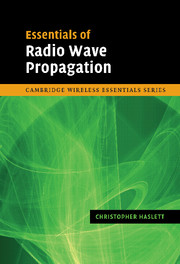Book contents
- Frontmatter
- Contents
- Preface
- Acknowledgements
- 1 Propagation in free space and the aperture antenna
- 2 Point-to-area transmission
- 3 The effect of obstacles
- 4 Reflection, scatter and penetration
- 5 Estimating the received signal strength in complex environments
- 6 Atmospheric effects
- 7 System design and interference management
- 8 Software-based tools
- 9 Summary
- Appendix 1 The decibel scale
- Appendix 2 Phasor arithmetic and phasor diagrams
- Appendix 3 Formula sheet
- Appendix 4 Explanation of the link budget
- Further reading
- References
- Recommendations of the Radiocommunication Bureau of the International Telecommunications Union (ITU), Geneva
- Author's biography
- Index
3 - The effect of obstacles
Published online by Cambridge University Press: 09 August 2009
- Frontmatter
- Contents
- Preface
- Acknowledgements
- 1 Propagation in free space and the aperture antenna
- 2 Point-to-area transmission
- 3 The effect of obstacles
- 4 Reflection, scatter and penetration
- 5 Estimating the received signal strength in complex environments
- 6 Atmospheric effects
- 7 System design and interference management
- 8 Software-based tools
- 9 Summary
- Appendix 1 The decibel scale
- Appendix 2 Phasor arithmetic and phasor diagrams
- Appendix 3 Formula sheet
- Appendix 4 Explanation of the link budget
- Further reading
- References
- Recommendations of the Radiocommunication Bureau of the International Telecommunications Union (ITU), Geneva
- Author's biography
- Index
Summary
Predicting the strength of a radio signal in the shadow of an obstacle is a vital function for propagation engineers. The mechanism by which a wave enters into the shadow of an obstacle is known as diffraction. Even the simplest of practical obstacles pose severe mathematical challenges. More easily solved approximations are adopted in order to estimate the strength of diffracted signals. The starting point for diffraction problems is the case where a receiver is in the shadow of a perfectly absorbing ‘knife-edge’ obstacle. This is then extended to encompass the situation where there are several such obstacles on the path. Many approximate multiple-knife-edge prediction methods exist and the most commonly used are analysed and compared. More accurate ‘near-exact’ methods are discussed. Although these methods usually make better predictions of the signal strength in the shadow of obstacles, they require significantly more computing time as well as being significantly more complicated to implement. Once an understanding of the properties of a diffracted signal has been obtained, it is possible to derive clearance requirements for a point-to-point path so that diffraction effects may be safely ignored. The insights gained by investigating the mechanism of diffraction into the shadow of an obstacle can be used to analyse two related phenomena: reflection from a finite surface and the formation of the radiation pattern of an aperture antenna.
Knife-edge diffraction
Diffraction is the name given to the mechanism by which waves enter into the shadow of an obstacle.
- Type
- Chapter
- Information
- Essentials of Radio Wave Propagation , pp. 50 - 82Publisher: Cambridge University PressPrint publication year: 2007



